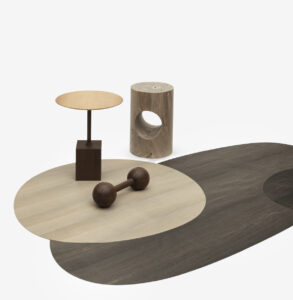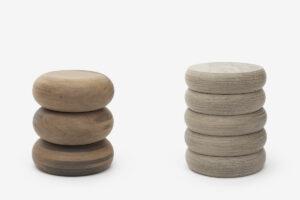“The perception is that nature indicates how to be more attentive, and how to avoid wasting resources.” This is how Elisa Ossino talks about a project that has been long in the making, but which has granted her the well-deserved opportunity to lay her hands on a precious material: riverbed logs, submerged for thousands of years (some over 8000 years old) found in the Balkans and transformed through innovative processes by Arte 9 Milano. The Friuli-based company that works completely in line with the tenets of the Circular Economy, along with partners selected for their shared philosophy, brings value to every phase of the work: from extraction done by hand, to avoid any possible alteration, to storage that calls for one year of drying, with constant control of temperature and humidity to achieve greater stability.
The logs of AbonosTM wood are labeled, numbered and divided by size, type and period of extraction. The wood, together with other sustainable materials, has been used to make Abstract Landscape, a set of one-offs presented during Milano Design City and created by Elisa Ossino, who has sensitively respected the memory of these elements.

“After entering the large warehouse where the timber is stored, covered with a blanket of jute – the designer says – when I saw the ‘beds’ I felt a very strong emotion – seeing them all together in this space meant feeling their energy. Furthermore, I was struck by one thing: the knots in the wood seemed like eyes, and it was as if I could glimpse faces.” Another fascinating factor for Elisa was the work of the artisans, since each piece is entirely made by hand. “It was exciting to get back to the tradition – she says – and to observe the women who know how to sand the wood so as to conserve its grain, without leaving signs, which is an operation that requires great skill.”
Know-how passed down from generation to generation, in this case enhanced by technological innovation. To make a carpet, for example, the thin sheets of wood have been bonded to a particular fabric that has been subjected to testing by Catas, resistant to abrasion and water. For the tables, the sheets have been glued to Palladian stone taken from an ancient quarry, obeying rigid regulations for the extraction.

“If we start to work with this kind of care, it will become a habit, and we will begin to realize how foolish we have been, in our indiscriminate use of the resources of our planet, and in our highly polluting working processes. The discovery of these marvelous logs is not by chance – it is as if they had returned to the surface to teach us something.” Something about the duty of human beings to relate to the environment with maximum respect and a focus on all types of biodiversity. For this reason, alongside the installation Abstract Landscape, there is an interactive video installation by the art group Kokoschka Revival, a hypnotic observation of animals in the world, as a pure, simple way of drawing attention to these themes.







